Last month, Russia began to amass troops close to its border with Ukraine. Kremlin top brass’s media interventions seeking to explain the buildup of around one hundred thousand troops were ambiguous: from reassurances that these were simple military exercises to effective threats of a full-fledged war if Ukraine should join NATO. The demonstrative character of these actions was surprising, given that the Kremlin still does not recognize that Russia was involved in the Donbas war that broke out in eastern Ukraine in 2014.
Yet conflict was averted. On April 22, Russian defense minister Sergei Shoigu announced that the exercise was over and the troops would move back to their home bases. This proved what many observers kept saying from the very beginning — that the buildup was a show of force more than anything else. The real aim of the maneuvers was not a new war but to mount pressure on Kyiv to make it yield in the Donbas conflict resolution process. However, even this scenario is prone to destabilize the situation in Ukraine.
More than seven years have passed since the signing of the Minsk agreements, which were supposed to reintegrate the self-proclaimed Luhansk People’s Republic and Donetsk People’s Republic (LDPR) into Ukraine. But this never happened. Donbas, a once-developed industrial region downgraded during the post-Soviet decades, has been further impoverished by the war, and is still divided by the front line.
The conflict, then, remains unresolved. Here, I will try to explain why this is the case, what explains the recent escalation, and what an internationalist socialist position on this issue might look like.
From Elections to Ceasefire
The escalation took place two years after the electoral victory of Volodymyr Zelenskiy, a Ukrainian comic-turned-politician who declared peace one of his major goals — explicitly calling for compromise. This was no easy task: from the very beginning, Zelenskiy had to deal with the stance of the former government and its followers, the far right, and Ukraine’s liberal-nationalist civil society, who opposed all concessions to Russia. The Kremlin was not willing to make serious concessions, either, but expected the new president to implement the previously reached accords put on the back burner by his predecessor.
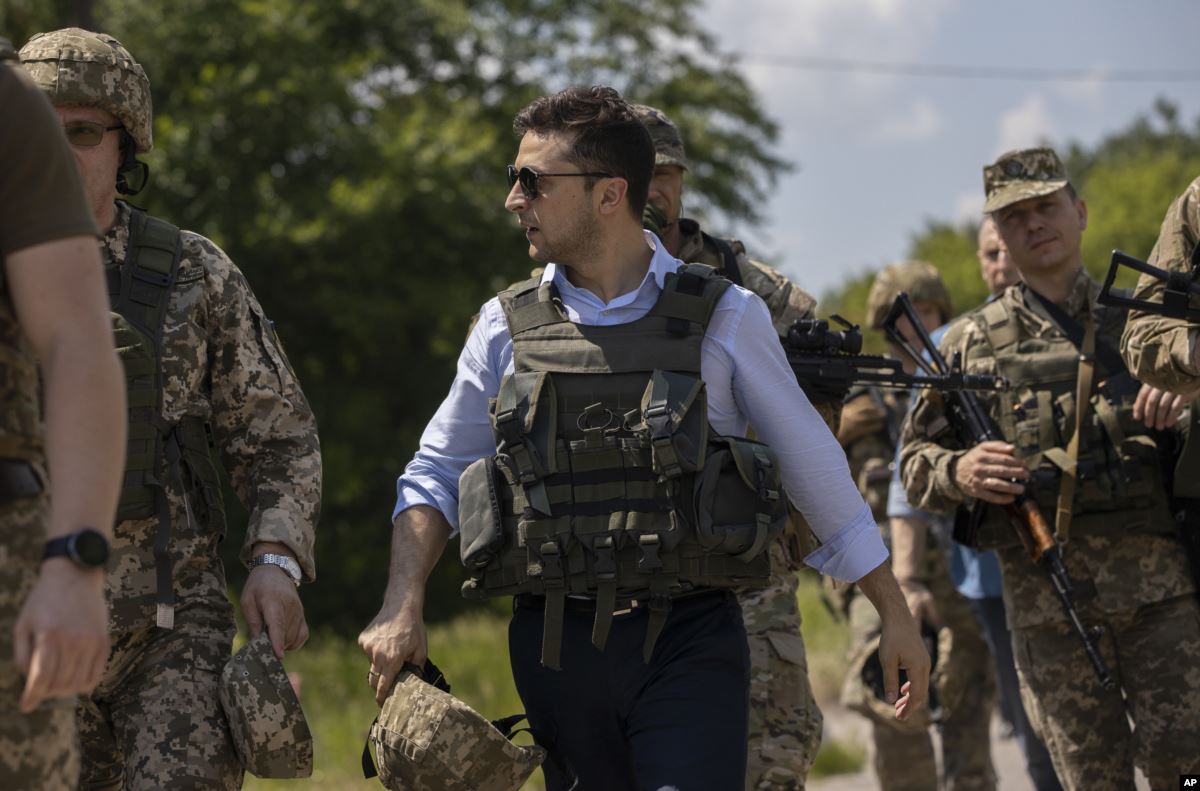
Volodymyr Zelenskiy
In his peacemaking efforts, Zelenskiy could only rely on so much popular support. Most Ukrainians agree that peace requires making some concessions, but none of the Kremlin’s specific demands is accepted by the majority of the Ukrainian population. Russia wants to negotiate directly with LDPR leaders, constitutionally fix the special status of the areas currently controlled by these formations, and organize local elections according to the separatists’ design. The prospects of peace were thus vague from the very start, making an uneasy truce the more realistic option.
Having failed in its attempts to reach a stable ceasefire at the front — and under pressure from hawks and the threat of a rebellion within the pro-presidential parliamentary faction — the government drew back from concessions. However, in July 2020, when many considered all chances lost, the signing of new agreements finally delivered an almost complete cessation of hostilities. This was the twentieth ceasefire since the beginning of the war, but it was unprecedented in its success. The number of ceasefire violations has been gradually growing on both sides since last autumn, but even now it remains much lower than in early 2020.

Protests against the “Steinmeier formula”
At the same time, peace negotiations have stalled in the first months of the truce. Ukraine was putting off discussions of political issues, while the Russians were refusing to discuss military and humanitarian issues before political demands were met. Namely, Ukraine has yet to implement the “Steinmeier formula,” which establishes the details of holding elections in LDPR. Zelenskiy agreed to this formula in the fall of 2019, which led to nationalist protests at home. In the summer of 2015, similar mass protests against a law granting special status to the separatist-held areas led to a deadly grenade explosion at the entrance to the national parliament. Meanwhile, LDPR have not implemented the agreement reached at the last meeting in Paris, which demands the opening of new border-crossing points and granting the Red Cross committee and other international organizations “full and unconditional access to all detained persons.”
Political Turn
In this situation, Zelenskiy has made a sudden political turn. In February 2021, the national security council levied personal sanctions against Viktor Medvedchuk, a Ukrainian oligarch and member of parliament whose political influence largely owes to his friendship with Vladimir Putin. In Ukrainian politics, structured by the divide between proponents of a rapprochement with Russia and partisans of the West, Medvedchuk occupied the extreme pro-Russian pole, and argued for conceding to all of the Kremlin’s demands. He gradually grew to dominate this camp after the outbreak of the war, which undermined other pro-Russian forces.
The main result of the sanctions against Medvedchuk has been the closure of three Ukrainian television channels that de facto belong to Medvedchuk, though they are formally owned by his close associate Taras Kozak. Much of their audience went to a channel with a similar editorial policy, whose owner, Yevheniy Muraev, has no connections with Putin and was unaffected by the sanctions. The legal reasoning behind them is more than questionable: the owners are accused of “financing terrorism” (i.e., owning a business in LDPR). Most likely, the sanctions will be contested in the European Court of Human Rights, but its judgment is not due anytime soon. Meanwhile, Zelenskiy has dealt a blow to Medvedchuk, reinforced his authority, and stopped the fall of his approval numbers.
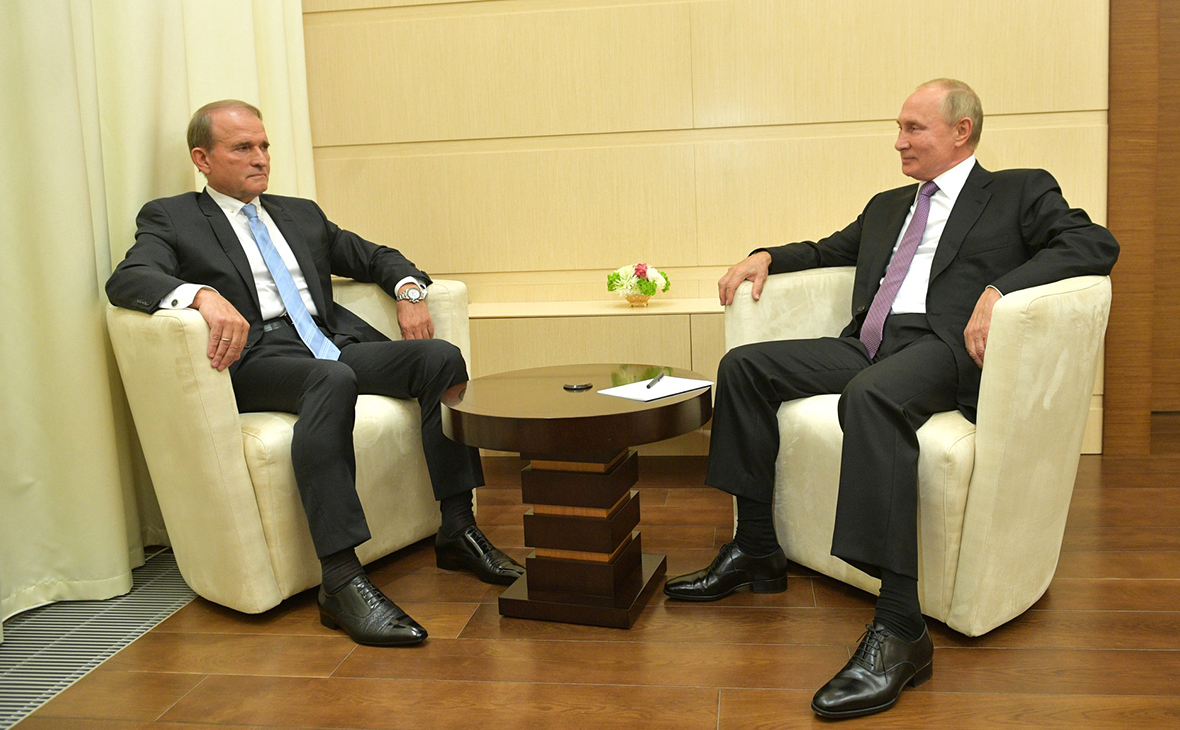
Viktor Medvedchuk and Vladimir Putin
The first mention of Medvedchuk’s channels by Zelenskiy dates back to 2019. A few months after his inauguration, he hinted that the channels are financed by Russia, saying that “this is going to be a huge story that will turn very nasty.” Most likely, he did not dare attack Putin’s friend while he still had hopes for peaceful resolution over Donbas. These constraints were lifted when the negotiations stalled.
Notwithstanding this political turn, Russian media claims about a planned offensive by Ukrainian troops, to which the Kremlin was allegedly reacting, were not corroborated by any serious evidence. Halting the hostilities in the Donbas has been a victory for Zelenskiy; he actively made use of this achievement in domestic politics and would unlikely abandon such an asset. The April buildup of Russian troops was more probably a reaction to Zelenskiy’s political moves and his unwillingness to make concessions.
The West’s Role
Zelenskiy’s political turn took place after the protests in Belarus, Biden’s inauguration in the United States, Navalny’s return, and the beginning of new protests in Russia. Possibly, a military buildup at the Ukrainian border and repression against young Russian leftists is Putin’s way of reacting to the perceived “aggression of the West” against him. But the actual role of the West in current events is harder to define.
At the beginning of the Russian troop buildup, relations between the leadership of Ukraine and the United States were quite uncertain. In January 2021, the United States levied sanctions against a member of the pro-president parliamentary faction, an associate of the oligarch Ihor Kolomoiskyi; sanctions against Kolomoiskyi himself followed in March. Zelenskiy used to be closely connected to Kolomoiskyi, but they had a falling out in 2020, and he publicly approved the US sanctions issued in March. In the meantime, Ukrainian media highlighted how long it took Biden to phone Zelenskiy after his inauguration. This silence was read as a lack of trust, which annoyed Kyiv; and only the Russian troop buildup finally made the phone ring.
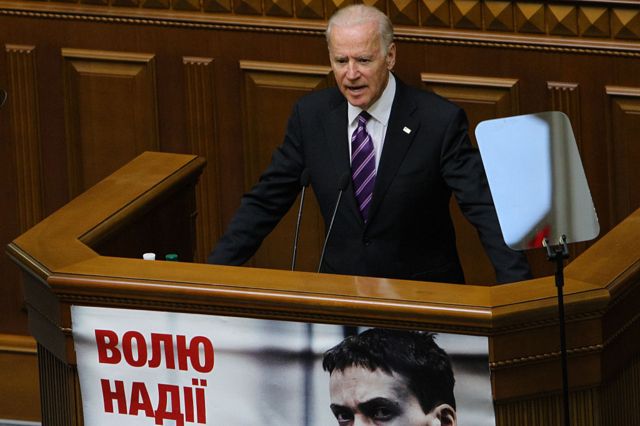
Joe Biden in Ukrainian parliament, 2015
If Biden’s administration played any role in the anti-Medvedchuk sanctions, it was likely by noninterference. Zelenskiy might not have ventured to make this step if the White House was still occupied by Trump, who kept saying that Zelenskiy should reach an agreement with Putin. With Biden, he had no misgivings that the Democratic administration condemns him. The same can be said about the EU. The sanctions were issued at the time when EU-Russia relations were at their lowest point in years, due to repression of the Russian opposition. Zelenskiy has chosen the right moment, when he did not need to worry that the EU would defend Medvedchuk, and thereby contributed to escalating tensions between Russia and the West.
Of all the parties implied, the EU is least interested in how exactly the conflict might be resolved. Its chief worry is to prevent a major war in its vicinity. Understanding this, the Kremlin threatens to unleash such a war when other methods of getting its way with Zelenskiy are inefficient. One of the results of the current standoff will likely be growing pressure on the part of Germany and France to make Zelenskiy implement the political part of the Minsk agreements — just as they made the previous Ukrainian president, Petro Poroshenko, sign these agreements in 2014.
The Minsk Agreements
In order to understand why the peace negotiations failed, one ought to look back at the history of the Minsk agreements. In August 2014, a few months after the beginning of the war, the Ukrainian Army was advancing and the troops of LDPR, mostly composed of local rebels armed by Russia and of Russian volunteers, were facing defeat. This is when Russia’s standing army began its massive offensive, which dramatically shifted the balance of forces and threw back Ukrainian troops.
Separatists by and large hoped that Russia would annex Donbas the same way it had annexed Crimea shortly before. But unlike with Crimea, the Kremlin did not need these territories as part of Russia. Maintaining an instable zone in the Donbas to exercise pressure on the Ukrainian government or reintegrating it into Ukraine to leverage its domestic politics were more lucrative options. Hence the signing of the Minsk Protocol when the Ukrainian government was facing a military defeat and the rebels were facing the threat of their aid from Russia being cut.
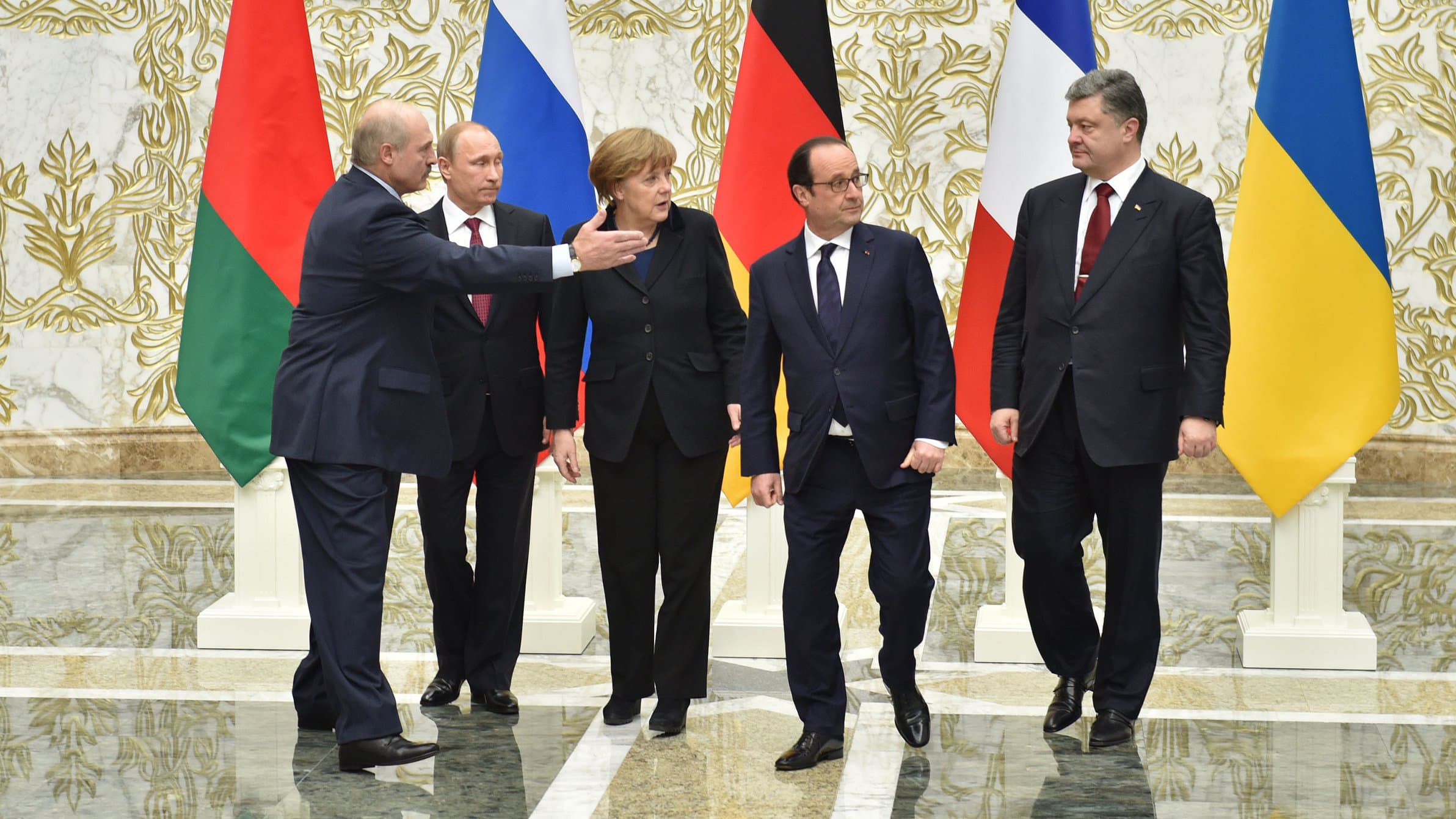
The agreement calls for the cessation of hostilities, an amnesty, the disbandment of illegal military formations, and the granting of special status to the territories controlled by the separatists. However, its implementation was ridden with problems from the very start. The hostilities became less intensive but did not cease, mainly for two reasons: unclear wording in the agreement and the unwillingness to implement it, both on the part of the Ukrainian government and the separatists. In order to solve the first problem, Russian and separatist troops delivered another military defeat to the Ukrainian government in January and February 2015 and made it sign a “Minsk 2” agreement with clarifications on many issues. To solve the second problem, the Kremlin pushed LDPR authorities to consolidate their power and tighten control; the dissident warlords were either forced to leave Donbas or killed.
As for the Ukrainian side, its basic understanding of the conflict differs from the Kremlin’s. The Kremlin keeps denying its involvement in the war and control over LDPR, positioning itself as an external mediator in the negotiations. Kyiv interprets this as a cheap bid to disown Russia’s responsibility for the ruined region and the war crimes perpetrated there. Ukraine does not formally recognize LDPR’s subjectivity, viewing the areas as occupied by Russia. The active participation of Ukrainian citizens in the political and military structures of LDPR is recognized but considered as collaboration with the occupying forces.
This leads to the asymmetry of the agreements. Their political aspect only involves the Ukrainian government, whereas the security and humanitarian part involves both parties. This is one of the reasons why Ukraine insists on tackling the security part first, while Russia and the separatists prefer to start with the political one. Meanwhile, LDPR have made a lot of political moves contrary to the Minsk agreements. Two months after Minsk, they organized elections, the results of which were not even falsified but simply invented — whereas the Minsk protocol called for holding elections according to a special law that was approved by Ukraine’s parliament. They also adopted constitutions in which they lay claims for areas under Kyiv’s control. However, since these constitutions are not formally recognized by anyone, this is not considered a violation as long as the LDPR leaders declare their commitment to the Minsk agreements.

The exact sequence of implementing most moves is not specified, which allows the parties to protract the process indefinitely. The deadlines that did figure in the agreements passed in 2015, but the step which figures first in both documents — the ceasefire — was only implemented last summer, and only for a month. Despite the clarifications in the subsequent documents, many items can still be interpreted in different ways. A reintegration along the lines suggested by Russia and the separatists could create a state within the state, without an actual restoration of Ukrainian sovereignty over the territories. For Kyiv, this means recognition of the LDPR authoritarian regimes and assuming the full financial burden of the region ruined by the war, without any guarantee that the conflict does not rekindle.
Meanwhile, the distance between the population on the two sides of the front line has been growing throughout these years. LDPR have gradually integrated into Russia’s economic, educational, and cultural space, even if they have not been politically recognized. Kyiv has introduced an economic blockade and discriminatory legal norms concerning residents of the territories outside of the government’s control. This has served only to further enhance their dislike for Ukraine and fear of political persecution in the case of a reintegration by Ukrainian script — especially given the very real problem of the far-right violence in Ukraine, which is not addressed by the authorities.
What Is to Be Done?
Predictions make little sense; instead, I would like to finish by suggesting a position that the Left could take. In my view, those who share the principles of internationalism and want to bring about a just resolution of the Donbas conflict should first and foremost demand that both parties reject military solutions. The last year’s truce was an undeniable achievement and an important step toward peaceful conflict transformation. It needs to be renewed and extended to gradually withdraw troops from the contact line on both sides. Also needed is a gradual renewal of communications across the separation line and a general de-escalation.
Zelenskiy’s policies deserve a lot of criticism, but no criticism exonerates the Russian military buildup at the Ukrainian border and the effective threat of starting a new war. This conflict should be resolved by way of compromises, and if one of the parties refuses to make concessions on certain issues, it may, and sometimes should, be criticized. But when one side resorts to war threats, the criticism against those who do not yield to the blackmail are different in principle from the criticism against the author of the blackmail.
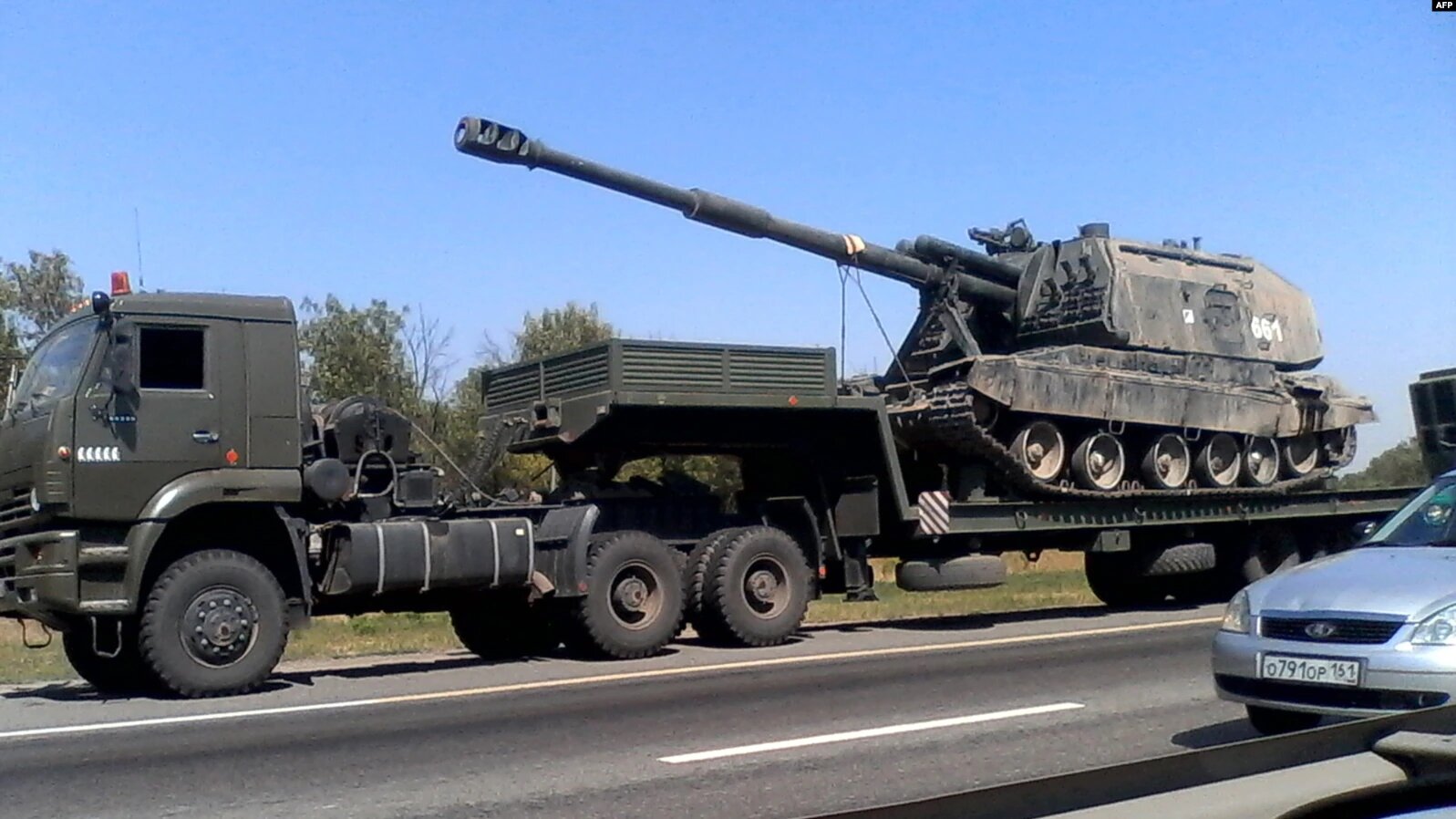
Despite all their drawbacks, the Minsk agreements are so far the only political accords agreed to by all parties. They contain important elements for resolving the conflict. As long as there is no alternative to them, the parties to the conflict should not reject them. However, they should not be fetishized, either.
In all likelihood, a sustainable peace requires the introduction of a UN peacekeeping mission or an Organization for Security and Co-operation in Europe police force in Donbas. A political resolution has to involve a new international treaty, or at least refresh the Minsk agreements. Among other things, such a treaty would launch an international program of reconstruction for the war-torn region, instead of putting this burden on one of East Europe’s poorest countries. In any case, it makes no sense to focus on adhering to the letter of agreements signed more than six years ago in very different and quite peculiar circumstances.
The societies on the two sides of the front line have evolved in different directions during the conflict years, and a rapid reintegration of LDPR into today’s Ukraine could provoke a wave of political violence during the implementation of the political part of the Minsk agreements, and an even greater destabilization afterwards. Both societies need to change for a successful reintegration. Ukraine has to cancel discriminatory laws concerning LDPR residents and solve the problem of the unpunished far-right violence, while in LDPR, the authoritarian regimes’ violation of human rights needs to change.
The war in the Donbas has split and weakened the Left in Ukraine. In 2014, some leftists supported the separatist uprising, others the Ukrainian Army, and the rest occupied a wide spectrum of positions between these extreme positions. But one way or another, all of them have been gradually marginalized. For a renaissance of the Ukrainian left, we need a de-escalation of the conflict, not a relapse into the nationalist strife around it.
See also:
The causes of Ukrainian crisis
Zelensky team's passing chance to end the war in Donbas
Organising for peace in Ukraine: an interview with Nina Potarska
The Ukrainian Government as the Point of Balance between Domestic and Foreign Capital



